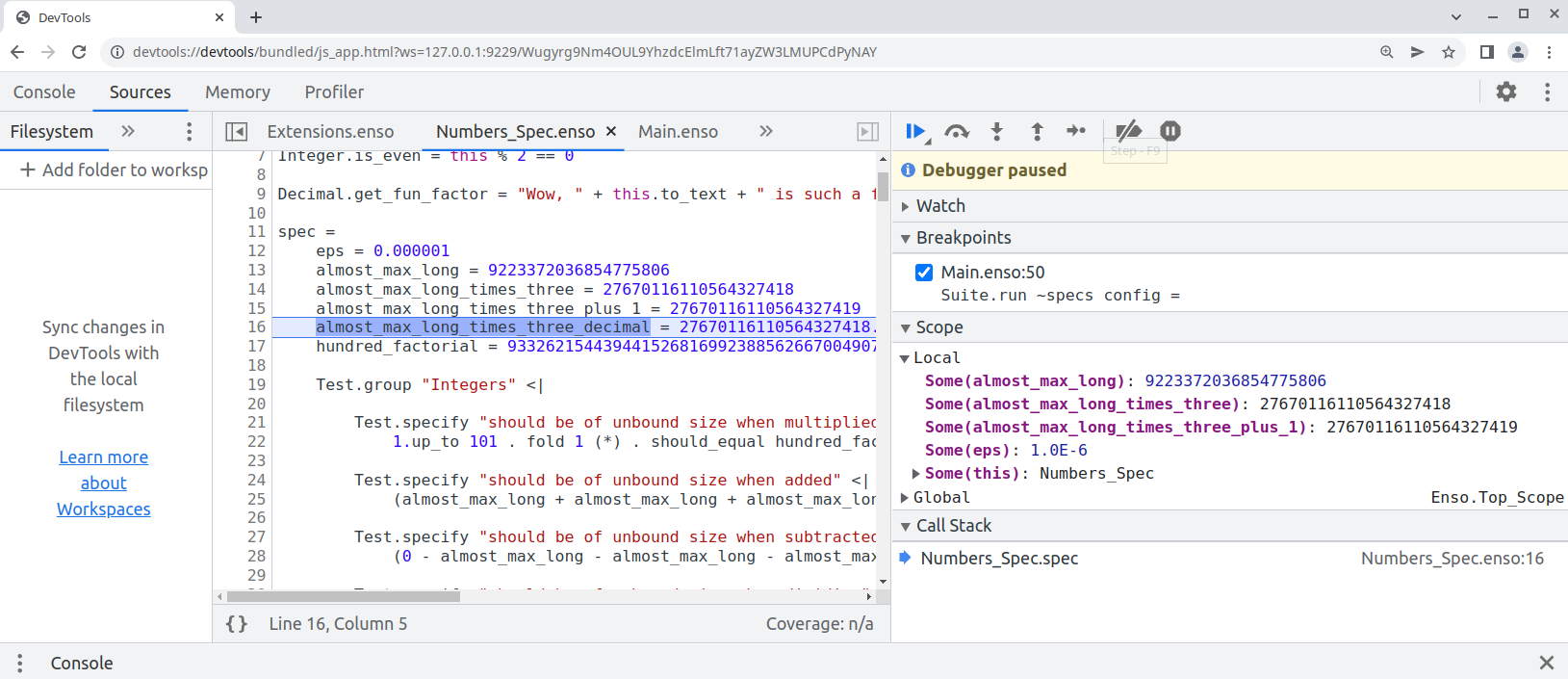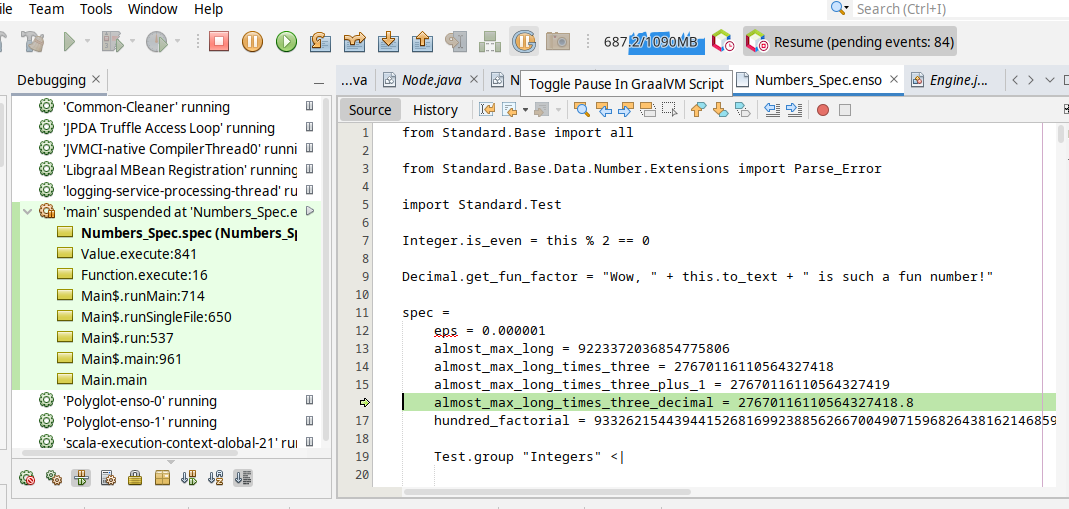@radeusgd discovered that no formatting was being applied to std-bits projects.
This was caused by the fact that `enso` project didn't aggregate them. Compilation and
packaging still worked because one relied on the output of some tasks but
```
sbt> javafmtAll
```
didn't apply it to `std-bits`.
# Important Notes
Apart from `build.sbt` no manual changes were made.
This PR extends the Component Group Entry with icon and option to highlight the text. Here the convert has highlighted "con".
https://user-images.githubusercontent.com/3919101/169046537-4f8b823c-322e-40dc-8abb-24d1d7092341.mp4
### Important Notes
Although this PR includes effort for adjusting Component Group style to better reflect the design, it is not entirely finished: the selection still works badly and will be fixed in another PR.
This is the 2nd part of DSL improvements that allow us to generate a lot of
builtins-related boilerplate code.
- [x] generate multiple method nodes for methods/constructors with varargs
- [x] expanded processing to allow for @Builtin to be added to classes and
and generate @BuiltinType classes
- [x] generate code that wraps exceptions to panic via `wrapException`
annotation element (see @Builtin.WrapException`
Also rewrote @Builtin annotations to be more structured and introduced some nesting, such as
@Builtin.Method or @Builtin.WrapException.
This is part of incremental work and a follow up on https://github.com/enso-org/enso/pull/3444.
# Important Notes
Notice the number of boilerplate classes removed to see the impact.
For now only applied to `Array` but should be applicable to other types.
Promoted `with`, `take`, `finalize` to be methods of Managed_Resource
rather than static methods always taking `resource`, for consistency
reasons.
This required function dispatch boilerplate, similarly to `Ref`.
In future iterations we will address this boilerplate code.
Related to https://www.pivotaltracker.com/story/show/182212217
[ci no changelog needed]
[Task link](https://www.pivotaltracker.com/story/show/181725003)
This PR implements a fully visible component group header while scrolling the group (using the ScrollArea).
The header moves in sync with scrolling movements (using new `set_header_pos` FRP input), so it looks like the component group is scrolled. ScrollArea masks the "scrolled" entries above the header. This design allows a fully visible header even though our renderer doesn't support nested layers masking yet.
The screencast:
https://user-images.githubusercontent.com/6566674/168320360-2c2017b2-0ef5-42ce-9c79-82b9641c1d73.mp4
The most recent one, with the updated demo scene from develop:
https://user-images.githubusercontent.com/6566674/168555268-8552c4b0-f887-4388-89a1-e65ddf668be6.mp4
# Important Notes
- I fixed the API of the list view so now it supports non-hardcoded scene layers (previously it did not). I also believe it was implemented incorrectly.
- I've found a [pretty weird bug](https://www.pivotaltracker.com/story/show/182193824): the component group inside the ScrollArea is invisible unless I add some arbitrary shape to the scroll area content. I use a `transparent_circle` for this purpose in the demo scene. The bug is probably related to masking the sublayers, though I wasn't able to reproduce it properly on a simpler example.
- The selection box is removed from the demo scene as agreed with @farmaazon . The correct implementation has proven to be much harder than I expected, and we will implement another approach in a separate PR.
- I also modified the `shadow::Parameters` so that it uses `Var`s instead of plain values.
The change promotes static methods of `Ref`, `get` and `put`, to be
methods of `Ref` type.
The change also removes `Ref` module from the default namespace.
Had to mostly c&p functional dispatch for now, in order for the methods
to be found. Will auto-generate that code as part of builtins system.
Related to https://www.pivotaltracker.com/story/show/182138899
* Extends the instrumentation of the code base and upgrades some FRPs to the newer API macro.
* Extends the run-graph demo scene to specify a profile via URL without recompilation.
* Fixes labels in the flame graph demo scene.
* Fixes an issue with loading profiles that contains escaped characters.
# Important Notes
* no longer contains the upgrade of the `text::View` to `define_endpoints_2`. This should be fixed as part of the text rendering rewrite.
[ci no changelog needed]
Before, when running Enso with `-ea`, some assertions were broken and the interpreter would not start.
This PR fixes two very minor bugs that were the cause of this - now we can successfully run Enso with `-ea`, to test that any assertions in Truffle or in our own libraries are indeed satisfied.
Additionally, this PR adds a setting to SBT that ensures that IntelliJ uses the right language level (Java 17) for our projects.
Parametrize the colors used in a Component Group view based on a single color passed to an FRP input.
Customizing the colors of a Component Group will be needed for the larger Component Group List panel. This customization will work as a visual hint for the User, helping them to distinguish different Component Groups in the panel. A single input color will be configured for every Component Group in the `package.yaml` file (see the Design Doc). Therefore, all shades of the color required by the Component Group view must be calculated from this single input color.
https://www.pivotaltracker.com/story/show/181725039
#### Visuals
The following screencast of the `component_group` debug scene shows how all required shades of color are calculated from a single input color. It also shows a new "dimmed" display mode of the Component Group. The debug scene does not support selecting entries in a "dimmed" Component Group, as this is not required by the Design Doc.
https://user-images.githubusercontent.com/273837/168074651-bf3d5ea5-99b0-4b69-9934-ad8565ffc54e.mov
The following is a screenshot of the Node Searcher, to demonstrate that it still works correctly:
<img width="623" alt="Screenshot 2022-05-09 at 17 13 01" src="https://user-images.githubusercontent.com/273837/167441109-e9a47b5a-45a2-4172-85ed-c593e43e02d6.png">
# Important Notes
- A new type `Params` was added in the `list_view::entry::Entry` trait. This was needed to allow passing FRP information to entries separately for every ListView instance.
- Note: `style_prefix` and `max_width_px` parameters of the `list_view::entry::Entry::new` function may get moved into the new `Params` type in the future. To save time, this was not attempted in this PR, as agreed with @farmaazon.
[ci no changelog needed]
* Extends the instrumentation of the code base and upgrades some FRPs to the newer API macro.
* Extends the run-graph demo scene to specify a profile via URL without recompilation.
* Fixes labels in the flame graph demo scene.
* Fixes an issue with loading profiles that contains escaped characters.
# Important Notes
[ci no changelog needed]
`provided` classifier is completely omitted in the update report so we
cannot filter on that during `.select`.
Instead, we only consider runtime configuration which lists all the
necessary dependencies needed to run things.
This is a follow up on #182093808. With this change frgaal compiler is no
longer packaged.
A low-hanging fruit where we can automate the generation of many
@BuiltinMethod nodes simply from the runtime's methods signatures.
This change introduces another annotation, @Builtin, to distinguish from
@BuiltinType and @BuiltinMethod processing. @Builtin processing will
always be the first stage of processing and its output will be fed to
the latter.
Note that the return type of Array.length() is changed from `int` to
`long` because we probably don't want to add a ton of specializations
for the former (see comparator nodes for details) and it is fine to cast
it in a small number of places.
Progress is visible in the number of deleted hardcoded classes.
This is an incremental step towards #181499077.
# Important Notes
This process does not attempt to cover all cases. Not yet, at least.
We only handle simple methods and constructors (see removed `Array` boilerplate methods).
- Implements various statistics on Vector
# Important Notes
Some minor codebase improvements:
- Some tweaks to Any/Nothing to improve performance
- Fixed bug in ObjectComparator
- Added if_nothing
- Removed Group_By_Key
Auxiliary sbt commands for building individual
stdlib packages.
The commands check if the engine distribution was built at least once,
and only copy the necessary package files if necessary.
So far added:
- `buildStdLibBase`
- `buildStdLibDatabase`
- `buildStdLibTable`
- `buildStdLibImage`
- `buildStdLibGoogle_Api`
Related to [#182014385](https://www.pivotaltracker.com/story/show/182014385)
Implement a command that launches the application, runs a series of steps (a "workflow"), writes a profile to a file, and exits.
See: [#181775808](https://www.pivotaltracker.com/story/show/181775808)
# Important Notes
- The command to capture run and profile is used like: `./run profile --workflow=new_project --save-profile=out.json`. Defining some more workflows (collapse nodes, create node and edit value) comes next; they are implemented with the same infrastructure as the integration-tests.
- The `--save-profile` option can also be used when profiling interactively; when the option is provided, capturing a profile with the hotkey will write a file instead of dumping the data to the devtools console.
- If the IDE panics, the error message is now printed to the console that invoked the process, as well as the devtools console. (If a batch workflow fails, this allows us to see why.)
- New functionality (writing profile files, quitting on command, logging to console) relies on Electron APIs. These APIs are implemented in `index.js`, bridged to the render process in `preload.js`, and wrapped for use in Rust in a `debug_api` crate.
In order to analyse why the `runner.jar` is slow to start, let's _"self sample"_ it using the [sampler library](https://bits.netbeans.org/dev/javadoc/org-netbeans-modules-sampler/org/netbeans/modules/sampler/Sampler.html). As soon as the `Main.main` is launched, the sampling starts and once the server is up, it writes its data into `/tmp/language-server.npss`.
Open the `/tmp/language-server.npss` with [VisualVM](https://visualvm.github.io) - you should have one copy in your
GraalVM `bin/jvisualvm` directory and there has to be a GraalVM to run Enso.
#### Changelog
- add: the `MethodsSampler` that gathers information in `.npss` format
- add: `--profiling` flag that enables the sampler
- add: language server processes the updates in batches
Finally this pull request proposes `--inspect` option to allow [debugging of `.enso`](e948f2535f/docs/debugger/README.md) in Chrome Developer Tools:
```bash
enso$ ./built-distribution/enso-engine-0.0.0-dev-linux-amd64/enso-0.0.0-dev/bin/enso --inspect --run ./test/Tests/src/Data/Numbers_Spec.enso
Debugger listening on ws://127.0.0.1:9229/Wugyrg9Nm4OUL9YhzdcElmLft71ayZW3LMUPCdPyNAY
For help, see: https://www.graalvm.org/tools/chrome-debugger
E.g. in Chrome open: devtools://devtools/bundled/js_app.html?ws=127.0.0.1:9229/Wugyrg9Nm4OUL9YhzdcElmLft71ayZW3LMUPCdPyNAY
```
copy the printed URL into chrome browser and you should see:

One can also debug the `.enso` files in NetBeans or [VS Code with Apache Language Server extension](https://cwiki.apache.org/confluence/display/NETBEANS/Apache+NetBeans+Extension+for+Visual+Studio+Code) just pass in special JVM arguments:
```bash
enso$ JAVA_OPTS=-agentlib:jdwp=transport=dt_socket,server=y,address=8000 ./built-distribution/enso-engine-0.0.0-dev-linux-amd64/enso-0.0.0-dev/bin/enso --run ./test/Tests/src/Data/Numbers_Spec.enso
Listening for transport dt_socket at address: 8000
```
and then _Debug/Attach Debugger_. Once connected choose the _Toggle Pause in GraalVM Script_ button in the toolbar (the "G" button):

and your execution shall stop on the next `.enso` line of code. This mode allows to debug both - the Enso code as well as Java code.
Originally started as an attempt to write test in Java:
* test written in Java
* support for JUnit in `build.sbt`
* compile Java with `-g` - so it can be debugged
* Implementation of `StatementNode` - only gets created when `materialize` request gets to `BlockNode`
Debug is not imported by default (let me know if it should be?)
# Important Notes
When Debug was part of Builtins.enso everything was imported. Let me know if the new setup is not as expected.
- Read in Excel files following the specification.
- Support for XLSX and XLS formats.
- Ability to select ranges and sheets.
- Skip Rows and Row Limits.
# Important Notes
- Minor fix to DelimitedReader for Windows